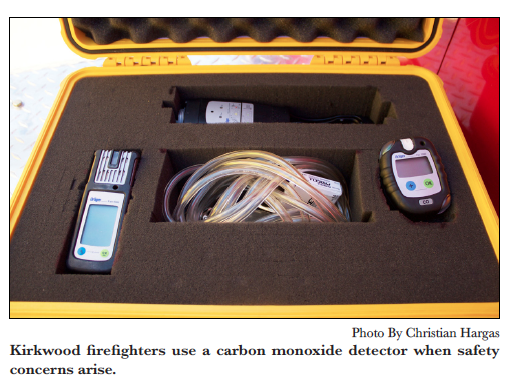STLCC-Meramec takes steps to prevent carbon monoxide leaks
 By: Christian Hargas
By: Christian Hargas
Sports Editor
Disease Control and Prevention, from 1999-2004, there were 439 carbon monoxide related deaths annually in the United States. Last August, North Mac Intermediate and Middle Schools in Girard, Ill. Evacuated 150 people following a carbon monoxide leak, according to NBC News.
Saint Louis Community College Chemistry Professor Tony Frost said carbon monoxide is dangerous because it cannot be easily monitored and improper venting is the main issue.
“Your body does not detect it. It is odorless, it is colorless and it is called the silent killer. However, its point sources are fairly unique – involving combustion. The main issue is the venting because when that does not happen properly, it [CO] will start to build up and you will not notice that building up and it could start to affect you,” Frost said.
It all depends on where the carbon monoxide leak is located, Meramec Campus Police Chief Tony Russo said.
“It could be centralized and it ultimately might end up closing down a building. It might end up closing down a small area that has detached-type buildings because we have several different types of buildings [on campus],” Russo said.
According to Kirkwood Assistant Chief and Fire Marshal Leo Meyer, carbon monoxide leaks occur more today because of the tighter sealing on modern structures.
“Before, you did not have as good of window insulation or good sealing of doors. Even if there was a carbon monoxide leak, you were still getting air circulating and keeping those levels low. Now our homes and businesses are so energy efficient, so air tight, that within minutes you can have those levels very high,” Meyer said.
Frost said careful monitoring and awareness of the potential leak is important.
“Make sure your chimneys are cleaned and not blocked. Make sure your sources of combustion are vented properly and do not leave your cars running in closed spaces. Also, make sure you are getting your appliances [furnaces, hot water heaters, etc.] inspected. A little bit of awareness is really the biggest thing to help you from running into this bad accumulation of gas,” Frost said.
Carbon monoxide leaks occur more in residential than commercial establishments because commercial buildings have maintenance crews come in checking areas such as furnaces, boilers and hot water heaters on a regular basis, Meyer said. “The other aspect is at commercials, and on the campus here, we do annual fire inspections twice a year. We do not go into the residences and do fire inspections on a regular basis. If someone would call and ask us to do one, we would be happy to. However, it is not something we do very often.”
Many home owners do a lot of the work themselves and not all of it is proper, Russo said.
“As inexpensive as they are, and I know there are regulations to the number of smoke alarms that you need to have, I think it would be a great idea to include carbon monoxide detectors.
They are not just alarms, but they tell you the amount of carbon monoxide levels in your house. You need to keep one, or however many, next to your fuel burning appliances. I think it is a good preventative act to save people,” Frost said.
On campus, there is a carbon monoxide detector wherever combustion is going on, Russo said.
“Even though our buildings are old, we have the ones that need it [detector] with carbon monoxide detectors. And we do regular maintenance on our equipment,” Russo said.
Widespread effects will not happen on the Meramec campus because it is big, Frost said.
STLCC has a very comprehensive emergency management plan for the four campuses, Russo said.
“We practice it very regularly all throughout the year with our several drills – including the evacuation drill in case of carbon monoxide. The first thing we would do is we would go to the building, observe it ourselves, open windows and start helping people out. Every building has a designated evacuation area. The fire department will show up and we will take care of it,” Russo said.
Once people have been helped and evacuated, crews are sent into the buildings to determine the levels of CO, what needs to be done and verifying evacuation and ventilation, Meyer said.
“Once we know everyone is back out of the building, we will probably close the building down again. We are going to try and recreate what happened, so we can pinpoint the location and isolate it,” Meyer said. “Once it is fixed, we will then monitor – with our monitors – to see if the problem reoccurs, or if it is completely corrected.”
Meramec is an extremely safe environment with not only handling carbon monoxide but handling other chemicals as well, Russo said. There are rules that everyone follows.
“As an educational facility, we are educating the faculty, maintenance workers, and the students to the degree of “if there is something suspected, we act on it right away. The maintenance portion is really on top of their game. They are doing their job and it is good,” Meyer said.
Meramec’s ability to keep the campus safe brings confidence, Frost said.
“I think we are as safe as any other location. I feel safe working here, especially in our area [sciences] because I know how well we are monitoring gases,” Frost said.










